New Understanding of the Early Cambrian Uplift–Depression Framework and the Large-Scale Source–Reservoir Distribution along the Margin of the Awati Sag in Tarim Basin, NW China
Abstract
:1. Introduction
2. Geological Setting

3. Materials and Methods
4. Results
4.1. Identification of the Uplift–Depression Framework
4.1.1. Basis for Drilling Formation Thickness
4.1.2. Basis for Field Outcrops
4.1.3. Basis for Seismic Profile
4.2. The Distribution of the Wensu Low Paleo-Uplift
5. Discussion
5.1. Formation and Evolution of the Uplift–Depression Framework
5.1.1. Formation and Extinction of the Paleo-Uplift
5.1.2. Formation and Extinction of the Uplift-Sag Framework
5.2. Formation and Evolution of the Uplift–Depression Framework
5.2.1. Control of the Development and Distribution of Source Rocks
5.2.2. Control of the Development and Distribution of Reservoir Rocks
5.2.3. The Significance of Source–Reservoir Controlling and Exploration
6. Conclusions
- Based on drilling data, field outcrops evaluations, thin section analysis, and 3D seismic data, Wensu low paleo-uplift was discovered in the Keping–Wensu area of the Tarim Basin. The planar distribution of the Wensu low paleo-uplift is typically demonstrated as a SW–NE trending nose structure, characterized by a far SW-trending extension, a narrow NE-trending extension, and an overall characteristic of being higher in the west and lower in the east.
- At the end of the Sinian period, the Tarim plate was uplifted as a whole, and Nanhuan–Sinian formations were denuded in the whole basin due to the influence of the Keping movement. In the Early Cambrian, the Tabei paleo-uplift evolved into the Wensu low paleo-uplift, which basically died out in the Middle Cambrian.
- In the Early Cambrian, the Wensu paleo-uplift controlled the development of high-quality source rocks in the Yurtusi Formation. The contemporaneous paleotectonic framework also controlled the formation of mound-shoal complexes and grain shoals, laying the foundation for high-quality reservoirs in the Xiaoerbulak and Wusonger Formations. Effective source–reservoir–cap assemblages were developed in the paleo-uplift area, constituting two sets of effective hydrocarbon accumulations in the upper and lower stratigraphic parts of the basin. The upper assemblage holds greater exploration potential, and is expected to be a next strategic target area for hydrocarbon exploration of Cambrian subsalt in the Keping–Wensu area.
Author Contributions
Funding
Data Availability Statement
Acknowledgments
Conflicts of Interest
References
- He, D.F.; Li, D.S.; Wu, X.Z.; Wen, Z. Basic types and structural characteristics of uplifts: An overview of sedimentary basins in China. Acta Geol. Sin. 2009, 83, 321–346. [Google Scholar] [CrossRef]
- Jiao, Z.F.; Gao, Z.Q. Formation, Evolution and Hydrocarbon-Controlling Geological Conditions of Major Paleohighs, Tarim Basin. Nat. Gas Geosci. 2008, 19, 639–646, (In Chinese with English Abstract). [Google Scholar]
- Yan, J.K.; Chen, H.L.; Cheng, X.G.; Chen, Y.Q.; Zeng, C.M.; Chen, C.; Wu, H.X. Migration of paleo-uplift in southwestern Tarim Basin and its implications for orogenesis and reservoir development, NW China. Petrol. Explor. Dev. 2023, 50, 99–110. [Google Scholar] [CrossRef]
- Goswami, P.K.; Pant, C.C.; Pandey, S. Tectonic controls on the geomorphic evolution of alluvial fans in the piedmont zone of ganga plain, uttarakhand, India. J. Earth Syst. Sci. 2009, 118, 245–259. [Google Scholar] [CrossRef]
- Xu, G.F.; Lin, C.S.; Liu, Y.F.; Sun, Q. Evolution of palaeo-uplift and its controlling on sedimentation of Kapushaliang Group of early cretaceous in western Tabei uplift. Earth Sci. 2016, 41, 619–632, (In Chinese with English Abstract). [Google Scholar]
- Ji, Y.L.; Zhou, Y.; Kuang, J.; Wan, L.; Zhang, R.; Lu, C.H. The formation and evolution of Chepaizi-Mosuowan paleo-uplift and its control on the distributions of sedimentary facies in the Junggar Basin. Sci. China Earth Sci. 2010, 53, 818–831. [Google Scholar] [CrossRef]
- Gao, C.L.; Ji, Y.L.; Ren, Y.; Zhou, Y.; Jin, J.; Zhang, L.Y.; Li, Z.C.; Zhou, Y.Q.; Wu, H. Geomorphology and sedimentary sequence evolution during the buried stage of paleo-uplift in the Lower Cretaceous Qingshuihe Formation, Junggar Basin, northwestern China: Implications for reservoir lithofacies and hydrocarbon distribution. Mar. Pet. Geol. 2017, 86, 1224–1251. [Google Scholar] [CrossRef]
- Lin, D.L.; Xi, Z.D.; Tang, S.H.; Lash, G.G.; Guo, Q.L.; Wang, H.Y.; Zhu, Y.M. Organic matter enrichment in shale deposited proximal to paleo-uplifts and its impact on shale gas exploration. Palaeogeogr. Palaeocl. 2024, 633, 111900. [Google Scholar] [CrossRef]
- Liu, J.Y.; Steel, R.J.; Lin, C.S.; Yang, H.J.; Yang, Y.H.; Peng, L.; Gong, Y.; Chu, C.L. Geomorphology control on the development of reservoir depositional systems, devonian donghetang Formation in the Tabei uplift of the Tarim Basin, China. Mar. Pet. Geol. 2012, 38, 177–194. [Google Scholar] [CrossRef]
- Li, J.T.; Wang, R.; Qin, S.; Shi, W.Z.; Geng, F.; Luo, F.S.; Li, G.P.; Zhang, X. Evolution of Mesozoic paleo-uplifts and differential control on sedimentation on the southern margin of Kuqa Depression, Tarim Basin. Mar. Pet. Geol. 2024, 161, 106707. [Google Scholar] [CrossRef]
- Kingston, D.R.; Dishroon, C.P.; Williams, P.A. Global basin classification system. AAPG Bull. 1983, 67, 2175–2193. [Google Scholar]
- Liang, X.P.; Jin, Z.J.; Philippov, V.; Obryadchikov, O.; Zhong, D.K.; Liu, Q.Y.; Uspensky, B.; Morozov, V. Sedimentary characteristics and evolution of Domanik facies from the Devonian–Carboniferous regression in the southern Volga-Ural Basin. Mar. Pet. Geol. 2020, 119, 104438. [Google Scholar] [CrossRef]
- Li, W.; Yi, H.Y.; Hu, W.S.; Yang, C.; Xiong, X. Tectonic evolution of Caledonian palaeohigh in the sichuan Basin and its relationship with hydrocarbon accumulation. Nat. Gas. Ind. B 2014, 1, 58–65. [Google Scholar]
- Wei, G.Q.; Yang, W.; Du, J.H.; Xu, C.C.; Zou, C.N.; Xie, W.R.; Wu, S.J.; Zeng, F.Y. Tectonic features of Gaoshiti-Moxi paleo-uplift and its controls on the formation of a giant gas field, Sichuan Basin, SW China. Petrol. Explor. Dev. 2015, 42, 283–292. [Google Scholar] [CrossRef]
- Qin, S.; Shi, W.Z.; Wang, R.; Liu, K.; Zhang, W.; Qi, R.; Xu, Q.H. Characteristics of Tight Sandstone Reservoirs and Their Controlling Factors of He-1 Member in Hangjinqi Block, Ordos Basin. Earth Sci. 2022, 47, 1604–1618, (In Chinese with English Abstract). [Google Scholar]
- Yuan, H.; Yin, S.; Dong, L.; Tan, C.Q. Restoration of the pre-Jurassic paleogeomorphology and its control on hydrocarbon distribution in western Ordos Basin. Energy Geosci. 2022, 3, 485–494. [Google Scholar] [CrossRef]
- Mao, D.F.; He, D.F.; Bao, H.P.; Wei, L.B.; Xu, Y.H.; Cheng, X.; Gou, J.Y.; Wu, S.J. Distribution, evolution and structural properties of Wushenqi paleo-uplift in Ordos Basin, NW China. Petrol. Explor. Dev. 2023, 50, 865–877. [Google Scholar] [CrossRef]
- Yue, Y.; Tian, J.C.; Zhao, Y.Q.; Wang, M.; Xie, P.Y. Control of Hetian Paleo-Uplift on Hydrocarbon Accumulation of Ordovician, Tarim Basin. Earth Sci. 2018, 43, 4215–4225, (In Chinese with English Abstract). [Google Scholar]
- Zhang, Z.Y.; Zhu, G.Y.; Zhang, Y.J.; Han, J.F.; Li, T.T.; Wang, E.Z.; Greenwood, P. The origin and accumulation of multi-phase reservoirs in the east Tabei uplift, Tarim Basin, China. Mar. Pet. Geol. 2018, 98, 533–553. [Google Scholar] [CrossRef]
- Liu, Y.L.; Gao, Y.J.; Zhang, J.F.; Bai, Z.K.; Cheng, M.H.; Zhang, Y.Y.; Yang, Y.X. New understanding of tectonic characteristic of the Wensu salient in Tarim Basin. Acta Pet. Sin. 2022, 38, 2665–2680, (In Chinese with English Abstract). [Google Scholar]
- Zhang, J.F.; Gao, Y.J.; Yang, Y.X.; Zhou, X.G.; Zhang, J.H.; Zhang, Y.Y. Oil exploration breakthrough in the Wensu salient, northwest Tarim Basin and its implications. Petrol. Explor. Dev. 2019, 46, 16–26. [Google Scholar] [CrossRef]
- Zhu, Y.J.; Zheng, J.F.; Cao, P.; Qiao, Z.F.; Yu, G.; Liu, L.L.; Huang, L.L. Tectonic-Lithofacies Paleogeography and Sizeable Reservoir Potential in the Early Cambrian Postrift Depressed Carbonate Ramp, Tarim Basin, NW China. Lithosphere 2021, 8804537. [Google Scholar] [CrossRef]
- Wu, G.Y.; Li, Y.J.; Liu, Y.L.; Zhao, Y. Paleozoic sedimento-tectonic evolution and basin dynamic settings in Wushi-Kalpin-Bachu area, northwest Tarim. J. Palaeogeogr. 2013, 15, 203–218, (In Chinese with English Abstract). [Google Scholar]
- Lin, C.S.; Li, S.T.; Liu, J.Y.; Qian, Y.X.; Luo, H.; Chen, J.Q.; Peng, L.; Rui, Z.F. Tectonic framework and paleogeographic evolution of the Tarim basin during the Paleozoic major evolutionary stages. Acta Pet. Sin. 2011, 27, 210–218, (In Chinese with English Abstract). [Google Scholar]
- Wei, G.Q.; Zhu, Y.J.; Zheng, J.F.; Yu, G.; Ni, X.F.; Yan, L.; Tian, L.; Huang, L.L. Tectonic-lithofacies paleogeography, large-scale source-reservoir distribution and exploration zones of Cambrian subsalt formation, Tarim Basin, NW China. Petrol. Explor. Dev. 2021, 48, 1289–1303. [Google Scholar] [CrossRef]
- Liu, W.; Zhang, G.Y.; Pan, W.Q.; Deng, S.H.; Li, H.H. Lithofacies palaeogeography and sedimentary evolution of the Cambrian in Tarim area. J. Palaeogeogr. 2011, 13, 529–538, (In Chinese with English Abstract). [Google Scholar]
- Pan, W.Q.; Chen, Y.Q.; Xiong, Y.X.; Li, B.H.; Xiong, R. Sedimentary facies research and implications to advantaged exploration regions on Lower Cambrian source rocks, Tarim basin. Oil Gas Geol. 2015, 26, 1224–1232, (In Chinese with English Abstract). [Google Scholar]
- Zhu, D.; Meng, Q.; Jin, Z.; Liu, Q.; Hu, W. Formation mechanism of deep Cambrian dolomite reservoirs in the Tarim basin, northwestern China. Mar. Pet. Geol. 2015, 59, 232–244. [Google Scholar] [CrossRef]
- Du, J.H.; Pan, W.Q. Accumulation conditions and play targets of oil and gas in the Cambrian subsalt dolostone, Tarim Basin, NW China. Petrol. Explor. Dev. 2016, 45, 1111–1126, (In Chinese with English Abstract). [Google Scholar]
- Wang, Z.; Gao, Z.; Fan, T.; Shang, Y.; Qi, L.; Yun, L. Structural characterization and hydrocarbon prediction for the SB5M strike-slip fault zone in the Shuntuo Low Uplift, Tarim Basin. Mar. Pet. Geol. 2020, 117, 104418. [Google Scholar] [CrossRef]
- Deng, S.; Liu, Y.Q.; Liu, J.; Han, J.; Wang, B.; Zhao, R. Structural styles and evolution models of intracratonic strike-slip faults and the implications for reservoir exploration and appraisal: A case study of the Shunbei area, Tarim Basin. Geotecton. Metal. 2020, 45, 1111–1126, (In Chinese with English Abstract). [Google Scholar]
- Zhu, G.Y.; Cheng, F.R.; Chen, Z.Y.; Zhang, Y.; Xing, X.; Tao, X.W.; Ma, D.B. Discovery and basic characteristics of the high-quality source rocks of the Cambrian Yuertusi Formation in Tarim Basin. Nat. Gas. Geosci. 2016, 27, 8–21, (In Chinese with English Abstract). [Google Scholar] [CrossRef]
- Zhai, M.G. The main old lands in China and assembly of Chinese unified continent. Sci. China Earth Sci. 2013, 56, 1829–1852. [Google Scholar] [CrossRef]
- Wu, G.H.; Li, H.W.; Xu, Y.L.; Su, W.; Chen, Z.Y. The tectonothermal events, architecture and evolution of Tarim craton basement palaeo-uplifts. Acta Pet. Sin. 2012, 28, 2435–2452, (In Chinese with English Abstract). [Google Scholar]
- Li, Z.X.; Powell, C.M.A. An outline of the palaeogeographic evolution of the Australasian region since the beginning of the Neoproterozoic. Earth Sci. Rev. 2001, 53, 237–277. [Google Scholar] [CrossRef]
- Wu, L.; Guan, S.W.; Feng, X.Q.; Ren, R.; Zhang, C.Y. Discussion on stratigraphic division of the Nanhuan and Sinian of the Tarim Basin and its surrounding region. Acta Petrol. Sin. 2020, 36, 3427–3441, (In Chinese with English Abstract). [Google Scholar]
- Yan, W.; Wu, G.H.; Zhang, Y.Q.; Yang, G.; Lou, H.; Wang, X.M. Sinian-Cambrian tectonic framework in the Tarim Basin and its influences on the paleogeography of the Early Cambrian. Geotecton. Metallog. 2018, 42, 455–466, (In Chinese with English Abstract). [Google Scholar]
- Zhu, G.Y.; Chen, Z.Y.; Chen, W.Y.; Yan, H.H.; Zhang, P.H. Revisiting to the Neoproterozoic tectonic evolution of the Tarim Block, NW China. Precambrian Res. 2021, 352, 106013. [Google Scholar] [CrossRef]
- Turner, S.A. Sedimentary record of late Neoproterozoic rifting in the NW Tarim Basin, China. Precambrian Res. 2010, 181, 85–96. [Google Scholar] [CrossRef]
- Tian, L.; Zhang, H.Q.; Liu, J.; Zhang, N.C.; Shi, X.Q. Distribution of Nanhua-Sinian rifts and proto-type basin evolution in southwestern Tarim Basin, NW China. Petrol. Explor. Dev. 2020, 47, 1206–1217. [Google Scholar] [CrossRef]
- Yang, X.; Li, H.L.; Zhang, Z.P.; Chen, Q.L.; Chen, Y.; Xiong, P. Evolution of Neoproterozoic Tarim Basin in Northwestern China and Tectonic Background of the Lower Cambrian Hydrocarbon Source Rocks. Acta Geol. Sin. 2017, 91, 1706–1719. [Google Scholar]
- Jin, Z.M.; Tan, X.C.; Tang, H.; Shen, A.J.; Qiao, Z.F.; Zheng, J.F.; Li, F.; Zhang, S.X.; Chen, L.; Zhou, C.G. Sedimentary environment and petrological features of organic-rich fine sediments in shallow water overlapping deposits: A case study of Cambrian Yuertus Formation in northwestern Tarim Basin, NW China. Petrol. Explor. Dev. 2020, 47, 476–489. [Google Scholar] [CrossRef]
- Li, J.H.; Jiang, H.F. Atlas of Global Plate Reconstruction, Paleo-Geography, and Paleo-Environment; Geology Press: Beijing, China, 2013. [Google Scholar]
- Li, J. The Study on the Genesis of Dolomite Reservoirs in Lower Cambrian Xiaoerbulake Formation in Tarim Basin. Master’s Dissertation, China University of Petroleum, Beijing, China, 2017. [Google Scholar]
- Yi, S.W.; Li, M.P.; Guo, X.J.; Yang, F.; Miao, W.D.; Lin, S.G.; Gao, Y. Breakthrough direction of Cambrian pre-salt exploration fields in Tarim Basin. Acta Petrol. Sin. 2019, 40, 1281–1295. [Google Scholar]
- Zhu, Y.J.; Shen, A.J.; Liu, L.L.; Chen, Y.Q.; Yu, G. Tectonic-sedimentary filling history through the Later Sinian to the Mid-Cambrian in Tarim Basin and its explorational potential. Acta Sediment. Sin. 2020, 38, 398–410, (In Chinese with English Abstract). [Google Scholar]
- Zhu, Y.J.; Zheng, J.F.; Zhang, J.K.; Luo, X.S.; Yu, G.; Liu, J.; Hu, F.J.; Yang, G. Facies, Depositional Environment and Reservoir Quality of an Early Cambrian Carbonate Ramp in the Tarim Basin, NW China. Minerals 2023, 13, 791. [Google Scholar] [CrossRef]
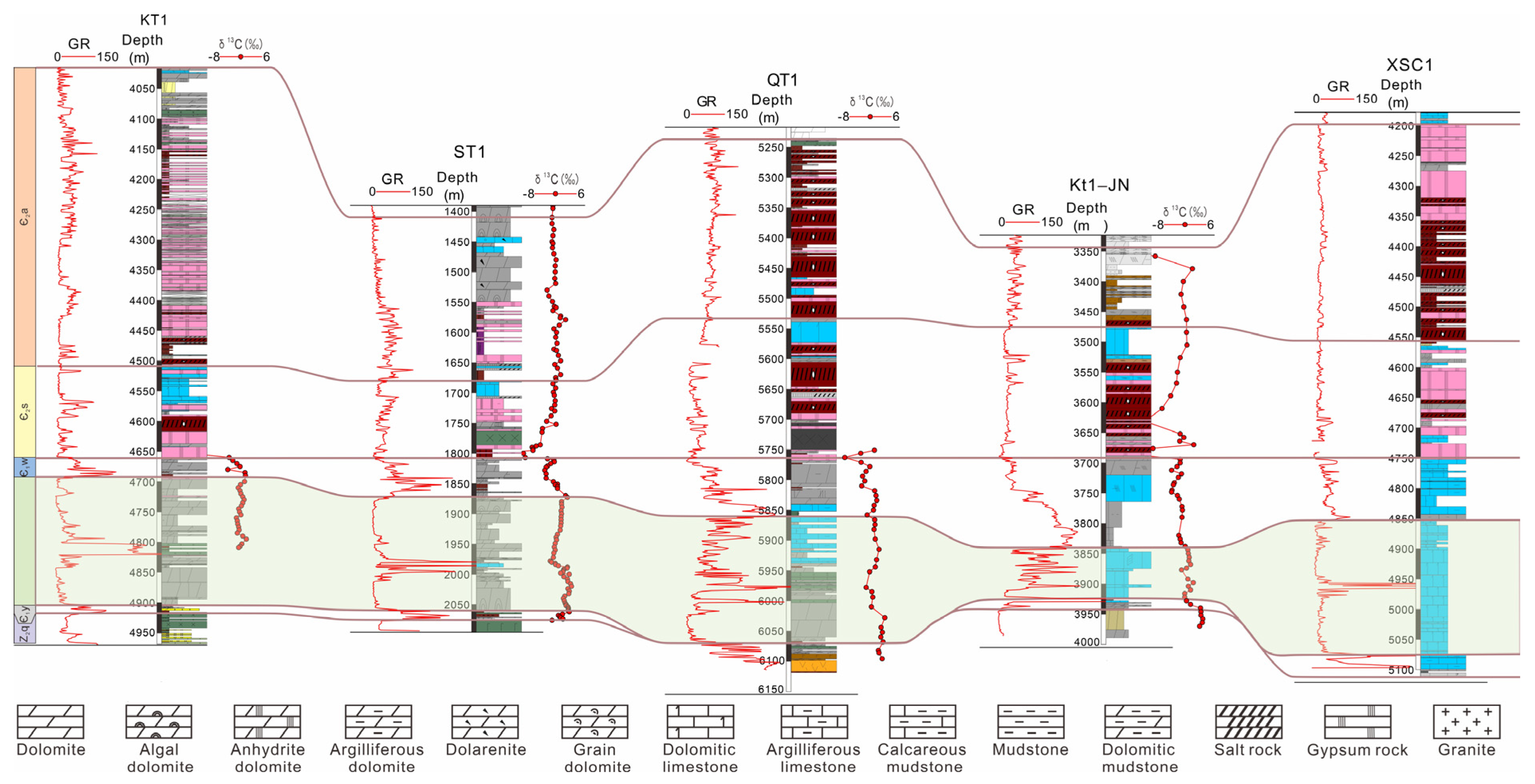
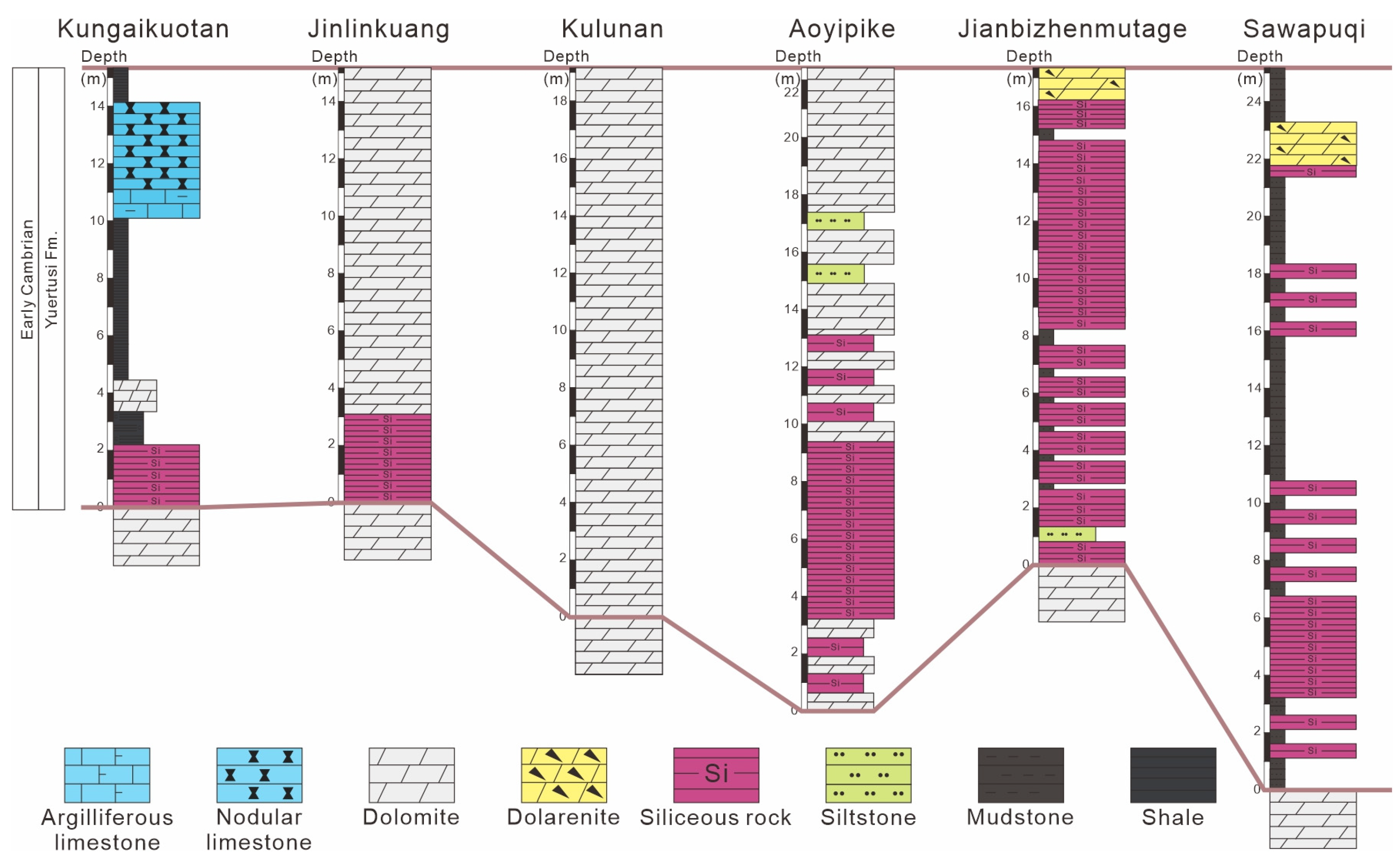


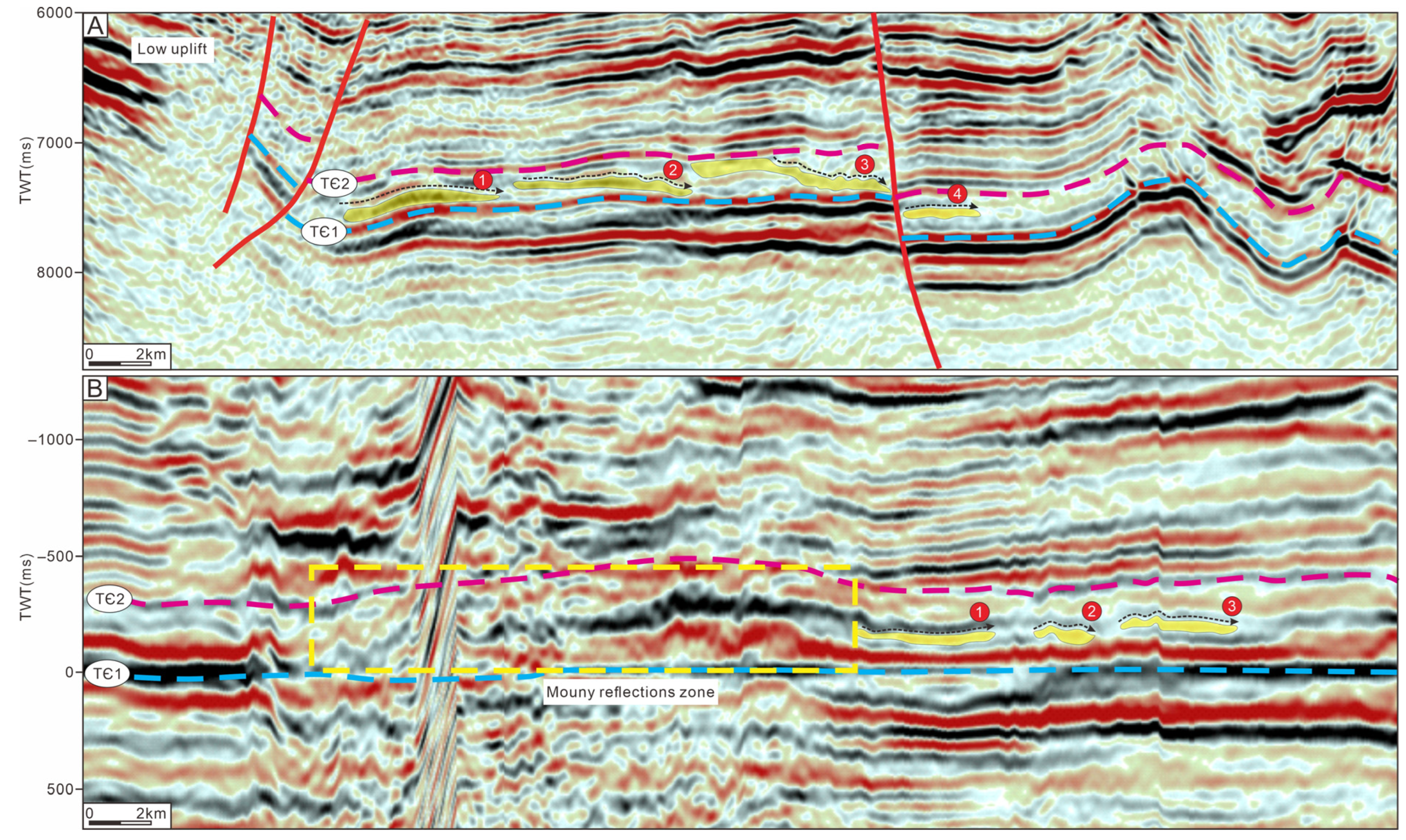
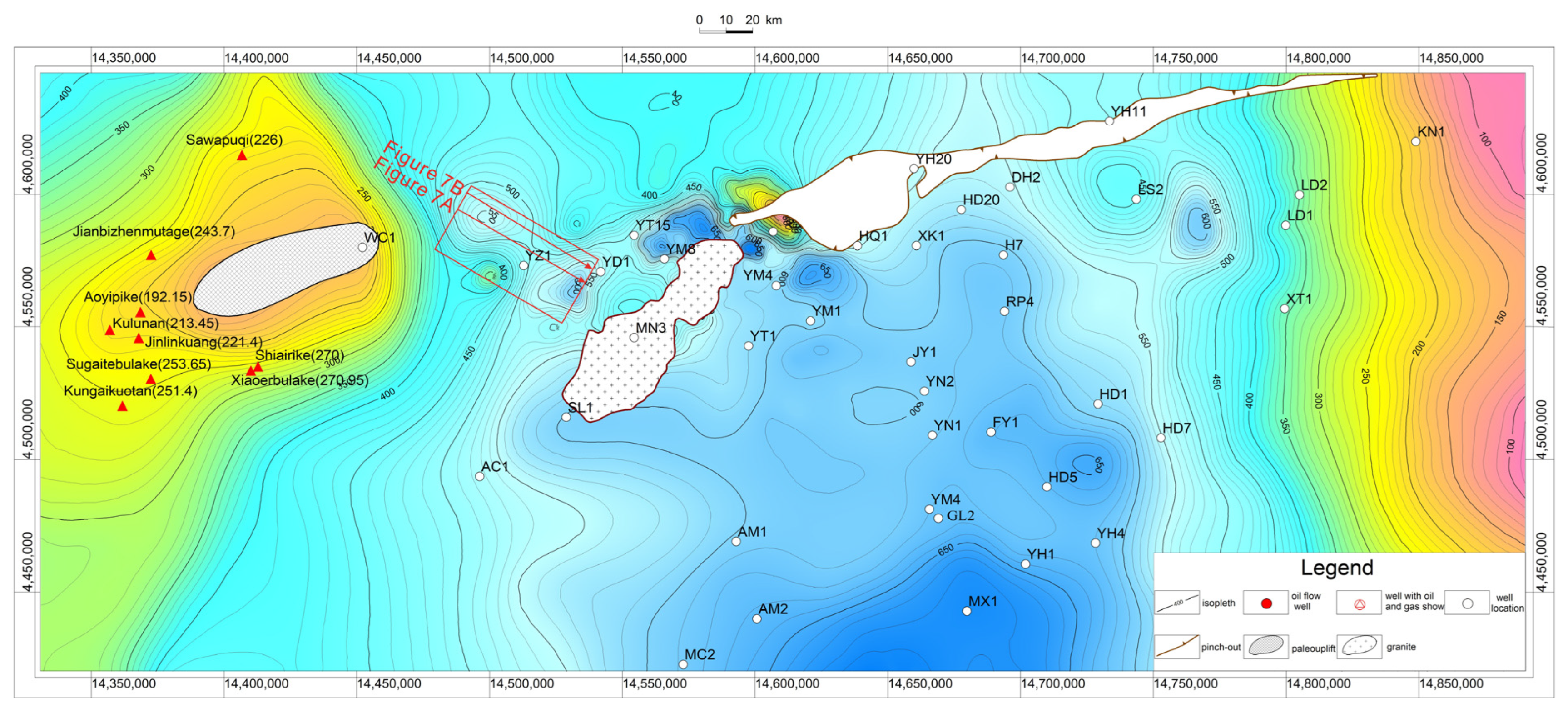

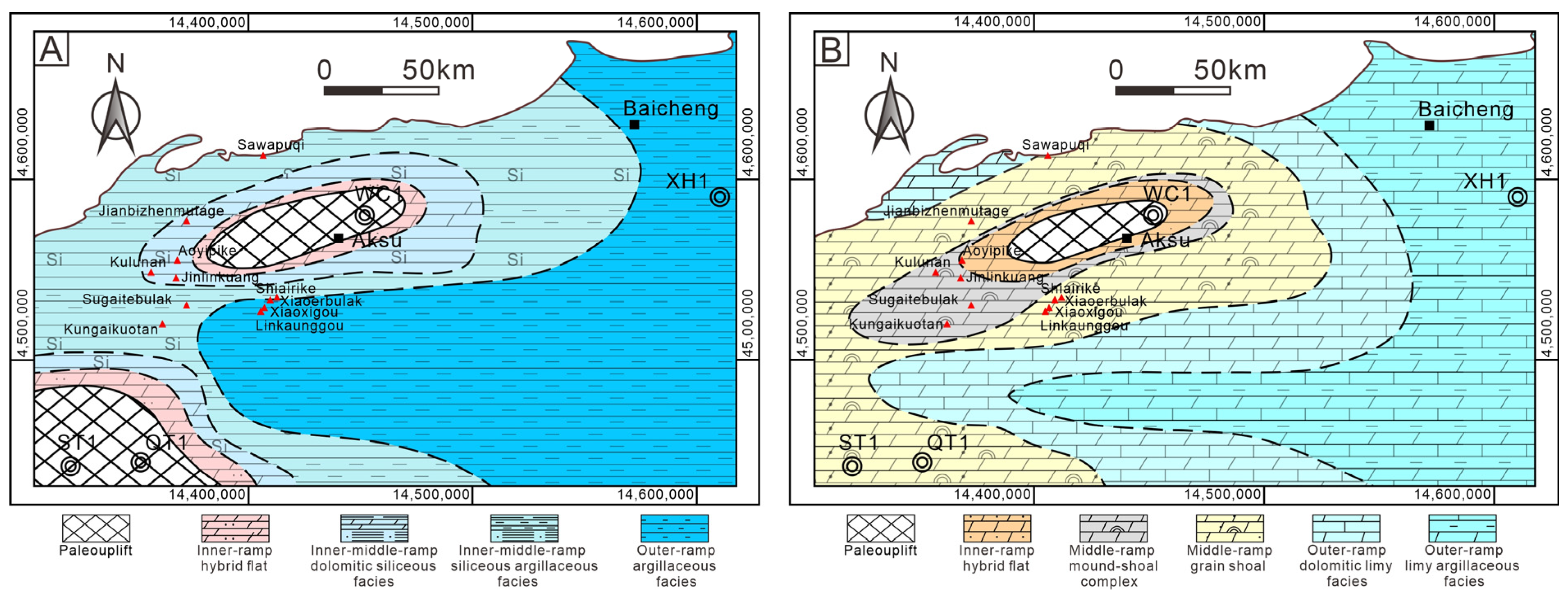
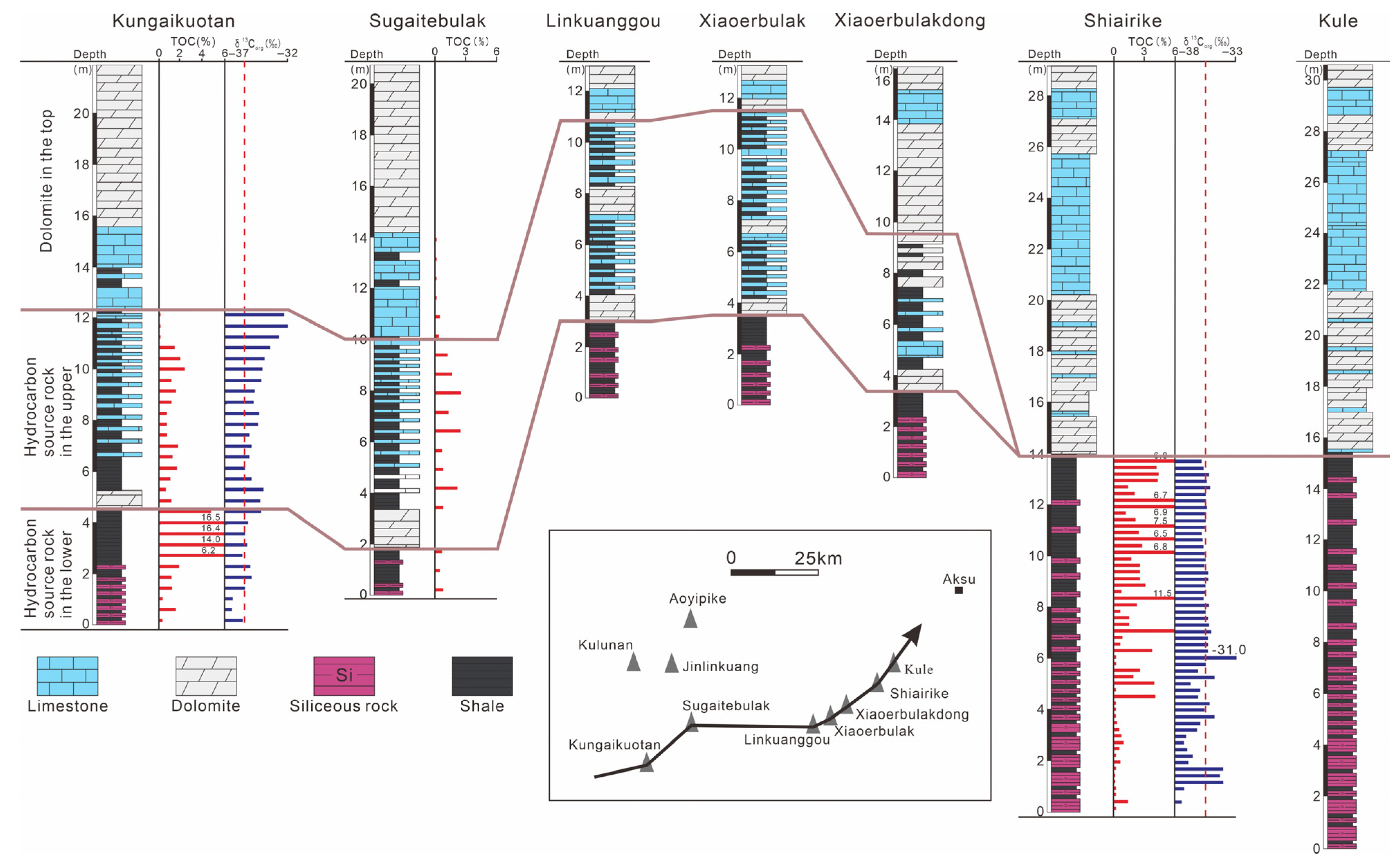
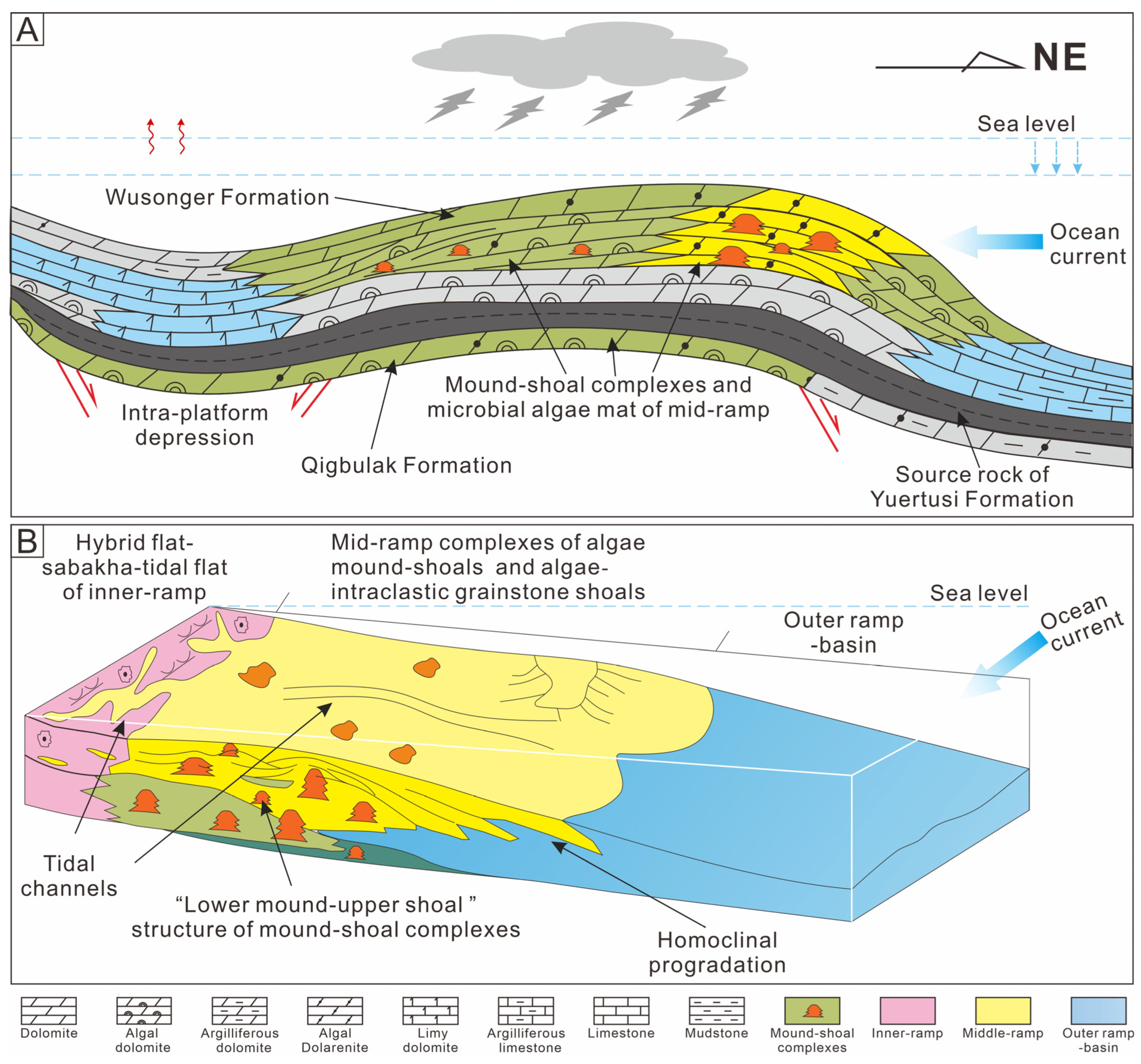

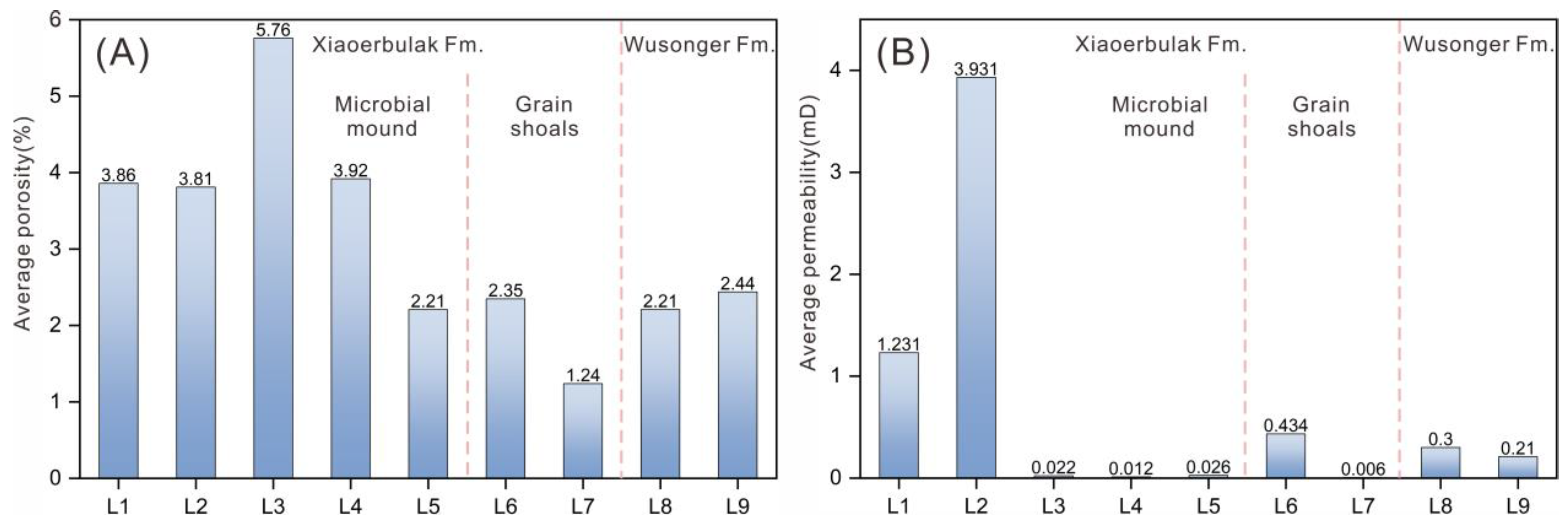
| Lithology | Code | Maximum Porosity (%) | Minimum Porosity (%) | Average Porosity (%) | Maximum Permeability (mD) | Minimum Permeability (mD) | Average Permeability (mD) |
|---|---|---|---|---|---|---|---|
| Laminated dolomite | L1 | 8.90 | 0.86 | 3.86 | 10.985 | 0.007 | 1.231 |
| Algal thrombolite dolomite | L2 | 8.06 | 1.95 | 3.81 | 74.410 | 0.006 | 3.931 |
| Spongiostromata dolomite | L3 | 10.92 | 1.22 | 5.76 | 0.057 | 0.006 | 0.022 |
| Algal framework dolomite | L4 | 5.25 | 2.59 | 3.92 | 0.017 | 0.009 | 0.012 |
| Stromatolite dolomite | L5 | 4.15 | 1.25 | 2.21 | 0.162 | 0.003 | 0.026 |
| Algal dolarenite | L6 | 4.90 | 0.93 | 2.35 | 4.046 | 0.007 | 0.434 |
| Crystalline (residual) grain dolomite | L7 | 1.74 | 0.91 | 1.24 | 0.009 | 0.003 | 0.006 |
| Micritic to crystalline powder-scale dolomite | L8 | 3.47 | 1.32 | 2.21 | 2.552 | 0.003 | 0.300 |
| Residual grain dolomite | L9 | 6.99 | 0.54 | 2.44 | 2.952 | 0.003 | 0.210 |
Disclaimer/Publisher’s Note: The statements, opinions and data contained in all publications are solely those of the individual author(s) and contributor(s) and not of MDPI and/or the editor(s). MDPI and/or the editor(s) disclaim responsibility for any injury to people or property resulting from any ideas, methods, instructions or products referred to in the content. |
© 2024 by the authors. Licensee MDPI, Basel, Switzerland. This article is an open access article distributed under the terms and conditions of the Creative Commons Attribution (CC BY) license (https://creativecommons.org/licenses/by/4.0/).
Share and Cite
Zhu, Y.; Zheng, J.; Chu, C.; Lyu, Q.; Tian, H.; Kang, T.; Zhang, T.; Huang, L. New Understanding of the Early Cambrian Uplift–Depression Framework and the Large-Scale Source–Reservoir Distribution along the Margin of the Awati Sag in Tarim Basin, NW China. Minerals 2024, 14, 646. https://doi.org/10.3390/min14070646
Zhu Y, Zheng J, Chu C, Lyu Q, Tian H, Kang T, Zhang T, Huang L. New Understanding of the Early Cambrian Uplift–Depression Framework and the Large-Scale Source–Reservoir Distribution along the Margin of the Awati Sag in Tarim Basin, NW China. Minerals. 2024; 14(7):646. https://doi.org/10.3390/min14070646
Chicago/Turabian StyleZhu, Yongjin, Jianfeng Zheng, Chunbo Chu, Qiqi Lyu, Haonan Tian, Tingting Kang, Tianfu Zhang, and Lili Huang. 2024. "New Understanding of the Early Cambrian Uplift–Depression Framework and the Large-Scale Source–Reservoir Distribution along the Margin of the Awati Sag in Tarim Basin, NW China" Minerals 14, no. 7: 646. https://doi.org/10.3390/min14070646







